Non-Invasive Preservation Assessment of Archaeological Animal Bones by Complementary Imaging Techniques
Abstract
1. Introduction
2. Materials and Methods
2.1. Sample Selection
2.2. Neutron and X-Ray Tomography
2.3. Attenuated Total Reflectance Fourier Transform Infrared Spectroscopy (ATR-FTIR)
2.4. Portable X-Ray Fluorescence (pXRF)
3. Results
3.1. Neutron and X-Ray Tomography
3.2. Attenuated Total Reflectance Fourier Transform Infrared Spectroscopy (ATR-FTIR)
3.3. Portable X-Ray Fluorescence (pXRF)
4. Discussion
5. Conclusions
Author Contributions
Funding
Data Availability Statement
Conflicts of Interest
References
- Chadefaux, C.; Le Hô, A.S.; Bellot-Gurlet, L.; Reiche, I. Curve-fitting micro-ATR-FTIR studies of the amide I and II bands of type I collagen in archaeological bone materials. E-Preserv. Sci. 2009, 6, 129–137. [Google Scholar]
- Lopes, D.; Martins-Cruz, C.; Oliveira, M.B.; Mano, J.F. Bone physiology as inspiration for tissue regenerative therapies. Biomaterials 2018, 185, 240–275. [Google Scholar] [CrossRef]
- Nielsen-Marsh, C.M.; Smith, C.; Jans, M.; Nord, A.; Kars, H.; Collins, M. Bone diagenesis in the European Holocene II: Taphonomic and environmental considerations. J. Archaeol. Sci. 2007, 34, 1523–1531. [Google Scholar] [CrossRef]
- Kendall, C.; Eriksen, A.M.H.; Kontopoulos, I.; Collins, M.J.; Turner-Walker, G. Diagenesis of archaeological bone and tooth. Palaeogeogr. Palaeoclim. Palaeoecol. 2018, 491, 21–37. [Google Scholar] [CrossRef]
- Kontopoulos, I.; Penkman, K.; Liritzis, I.; Collins, M.J. Bone diagenesis in a Mycenaean secondary burial (Kastrouli, Greece). Archaeol. Anthr. Sci. 2019, 11, 5213–5230. [Google Scholar] [CrossRef]
- Alvarez-Lloret, P.; Rodriguez-Navarro, A.B.; Romanek, C.S. Quantative analysis of bone mineral using FTIR. MACLA 2006, 6, 45–47. [Google Scholar]
- Kontopoulos, I.; Penkman, K.; Mullin, V.E.; Winkelbach, L.; Unterländer, M.; Scheu, A.; Kreutzer, S.; Hansen, H.B.; Margaryan, A.; Teasdale, M.D.; et al. Screening archaeological bone for palaeogenetic and palaeoproteomic studies. PLoS ONE 2020, 15, e0235146. [Google Scholar] [CrossRef]
- Brock, F.; Higham, T.; Ramsey, C.B. Pre-screening techniques for identification of samples suitable for radiocarbon dating of poorly preserved bones. J. Archaeol. Sci. 2010, 37, 855–865. [Google Scholar] [CrossRef]
- Child, A.M. Microbial Taphonomy of Archaeological Bone. Stud. Conserv. 1995, 40, 19–30. [Google Scholar] [CrossRef]
- Smith, C.I.; Nielsen-Marsh, C.; Jans, M.; Collins, M. Bone diagenesis in the European Holocene I: Patterns and mechanisms. J. Archaeol. Sci. 2007, 34, 1485–1493. [Google Scholar] [CrossRef]
- Cherns, L.; Spencer, A.R.; Rahman, I.A.; Garwood, R.J.; Reedman, C.; Burca, G.; Turner, M.J.; Hollingworth, N.T.; Hilton, J. Correlative tomography of an exceptionally preserved Jurassic ammonite implies hyponome-propelled swimming. Geology 2021, 50, 397–401. [Google Scholar] [CrossRef]
- Fernandez, V.; Buffetaut, E.; Suteethorn, V.; Rage, J.-C.; Tafforeau, P.; Kundrát, M.; Dodson, P. Evidence of Egg Diversity in Squamate Evolution from Cretaceous Anguimorph Embryos. PLoS ONE 2015, 10, e0128610. [Google Scholar] [CrossRef] [PubMed]
- Laaß, M.; Hampe, O.; Schudack, M.; Hoff, C.; Kardjilov, N.; Hilger, A. New insights into the respiration and metabolic physiology of Lystrosaurus. Acta Zool. 2010, 92, 363–371. [Google Scholar] [CrossRef]
- Burca, G. Combined Neutron Imaging and Diffraction: Instrumentation and Experimentation, in Faculty of Mathematics, Computing and Technology (MCT); The Open University: Ann Arbor, MI, USA, 2013. [Google Scholar]
- Bishop, M.C.; Dore, J.N. Corbridge: Excavations of the Roman Fort and Town 1947–1980, Archaeological Report; Historic Buildings & Monuments Commission for England: London, UK, 1988. [Google Scholar]
- Hare, J.N. Battle Abbey: The Eastern Range and the Excavations of 197-80, Vol. Archaeological Report no.2.; English Heritage: London, UK, 1985. [Google Scholar]
- Connell, B.; Davis, S. The Animal Bones. In Henry VIII’s Coastal Artillery Fort at Camber Castle, Rye, East Sussex; Biddle, M., Hiller, J., Scott, I., Eds.; Oxford Archaeological Unit for English Heritage: Oxford, UK, 2001; pp. 301–341. [Google Scholar]
- Rushmore, A. Housesteads Roman Fort-The Grandest Station: The Material Assemblages, Archaeological Reports; English Heritage: Swindon, UK, 2009; Volume 2. [Google Scholar]
- Burca, G.; Nagella, S.; Clark, T.; Tasev, D.; Rahman, I.; Garwood, R.; Spencer, A.; Turner, M.; Kelleher, J. Exploring the potential of neutron imaging for life sciences on IMAT. J. Microsc. 2018, 272, 242–247. [Google Scholar] [CrossRef] [PubMed]
- Burca, G.; Kockelmann, W.; A James, J.; E Fitzpatrick, M. Modelling of an imaging beamline at the ISIS pulsed neutron source. J. Instrum. 2013, 8, P10001. [Google Scholar] [CrossRef]
- Dierick, M.; Masschaele, B.; Van Hoorebeke, L. Octopus, a fast and user-friendly tomographic reconstruction package developed in LabView®. Meas. Sci. Technol. 2004, 15, 1366. [Google Scholar] [CrossRef]
- Avizo 9.0.1 FEI (2015) User’s Guide Avizo ® 9; Thermo Fisher: Waltham, MA, USA, 2015.
- Schindelin, J.; Arganda-Carreras, I.; Frise, E.; Kaynig, V.; Longair, M.; Pietzsch, T.; Preibisch, S.; Rueden, C.; Saalfeld, S.; Schmid, B.; et al. Fiji: An open-source platform for biological-image analysis. Nat. Methods 2012, 9, 676–682. [Google Scholar] [CrossRef]
- Drakopoulos, M.; Connolley, T.; Reinhard, C.; Atwood, R.; Magdysyuk, O.; Vo, N.; Hart, M.; Connor, L.; Humphreys, B.; Howell, G.; et al. I12: The Joint Engineering, Environment and Processing (JEEP) beamline at Diamond Light Source. J. Synchrotron Radiat. 2015, 22, 828–838. [Google Scholar] [CrossRef]
- Wasaeson, N.; Basham, M. Savu: A Python-based, MPI Framework for Simultaneous Processing of Multiple, N-dimensional Large Tomography Datasets. arXiv 2016, arXiv:1610.08015. [Google Scholar]
- Nicolet iS5 User Guide (2010); Thermo Fisher: Waltham, MA, USA, 2010.
- GRAMS AI 8.0 (2006); Thermo Fisher: Waltham, MA, USA, 2006.
- Van Loon, L.L.; McIntyre, N.S.; Bauer, M.; Sherry, N.S.; Banerjee, N.R. Peakaboo: Advanced software for the interpretation of X-ray fluorescence spectra from synchrotrons and other intense X-ray sources. Softw. Impacts 2019, 2, 100010. [Google Scholar] [CrossRef]
- Hillier, M.L.; Bell, L.S. Differentiating Human Bone from Animal Bone: A Review of Histological Methods. J. Forensic Sci. 2007, 52, 249–263. [Google Scholar] [CrossRef]
- Valtierra, N.; Courtenay, L.A.; Fabregat-Sanjuan, A.; López-Polín, L. Cleaning archaeological bones: Influence of water, ethanol, and acetone on microhardness. Int. J. Osteoarchaeol. 2023, 33, 967–972. [Google Scholar] [CrossRef]
- Pearce, C. Preservation Assessment of Archaeological Animal Bones using Combined Analytical and Advanced Imaging Techniques. Ph.D. Thesis, Birkbeck, University of London, London, UK, 2024. [Google Scholar]
- Paschalis, E.P.; Betts, F.; DiCarlo, E.; Mendelsohn, R.; Boskey, A.L. FTIR Microspectroscopic Analysis of Normal Human Cortical and Trabecular Bone. Calcif. Tissue Int. 1997, 61, 480–486. [Google Scholar] [CrossRef] [PubMed]
- Trueman, C.N.G.; Behrensmeyer, A.K.; Tuross, N.; Weiner, S. Mineralogical and compositional changes in bones exposed on soil surfaces in Amboseli National Park, Kenya: Diagenetic mechanisms and the role of sediment pore fluids. J. Archaeol. Sci. 2004, 31, 721–739. [Google Scholar] [CrossRef]
- Currey, J. Incompatible mechanical properties in compact bone. J. Theor. Biol. 2004, 231, 569–580. [Google Scholar] [CrossRef]
- Viguet-Carrin, S.; Garnero, P.; Delmas, P.D. The Role of Collagen in Bone Strength. Osteoporos. Int. 2005, 17, 319–336. [Google Scholar] [CrossRef]
- Boaks, A.; Siwek, D.; Mortazavi, F. The temporal degradation of bone collagen: A histochemical approach. Forensic Sci. Int. 2014, 240, 104–110. [Google Scholar] [CrossRef] [PubMed]
- Bouchard, G.P.; Mentzer, S.M.; Riel-Salvatore, J.; Hodgkins, J.; Miller, C.E.; Negrino, F.; Wogelius, R.; Buckley, M. Portable FTIR for on-site screening of archaeological bone intended for ZooMS collagen fingerprint analysis. J. Archaeol. Sci. Rep. 2019, 26, 101862. [Google Scholar]
- Lebon, M.; Reiche, I.; Gallet, X.; Bellot-Gurlet, L.; Zazzo, A. Rapid Quantification of Bone Collagen Content by ATR-FTIR Spectroscopy. Radiocarbon 2016, 58, 131–145. [Google Scholar] [CrossRef]
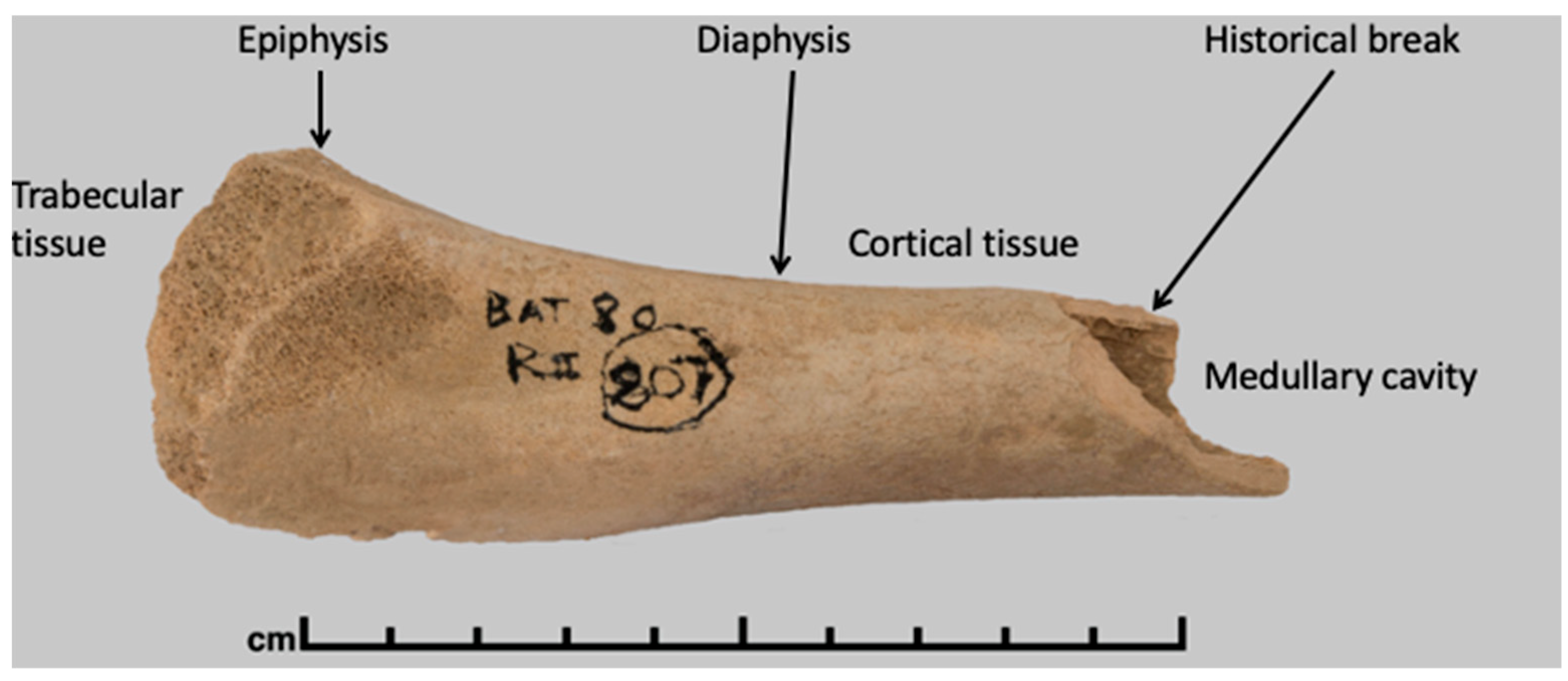
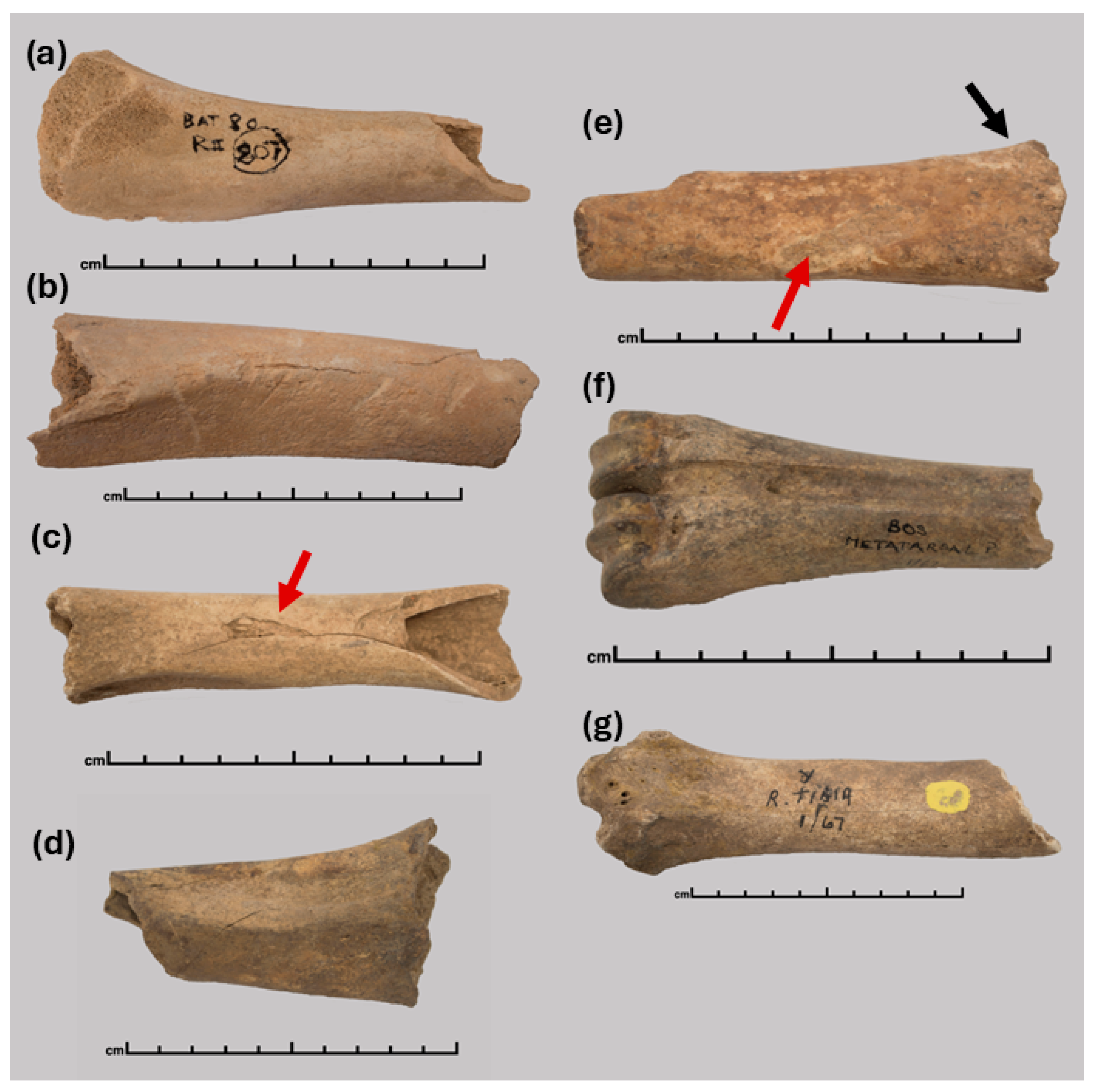

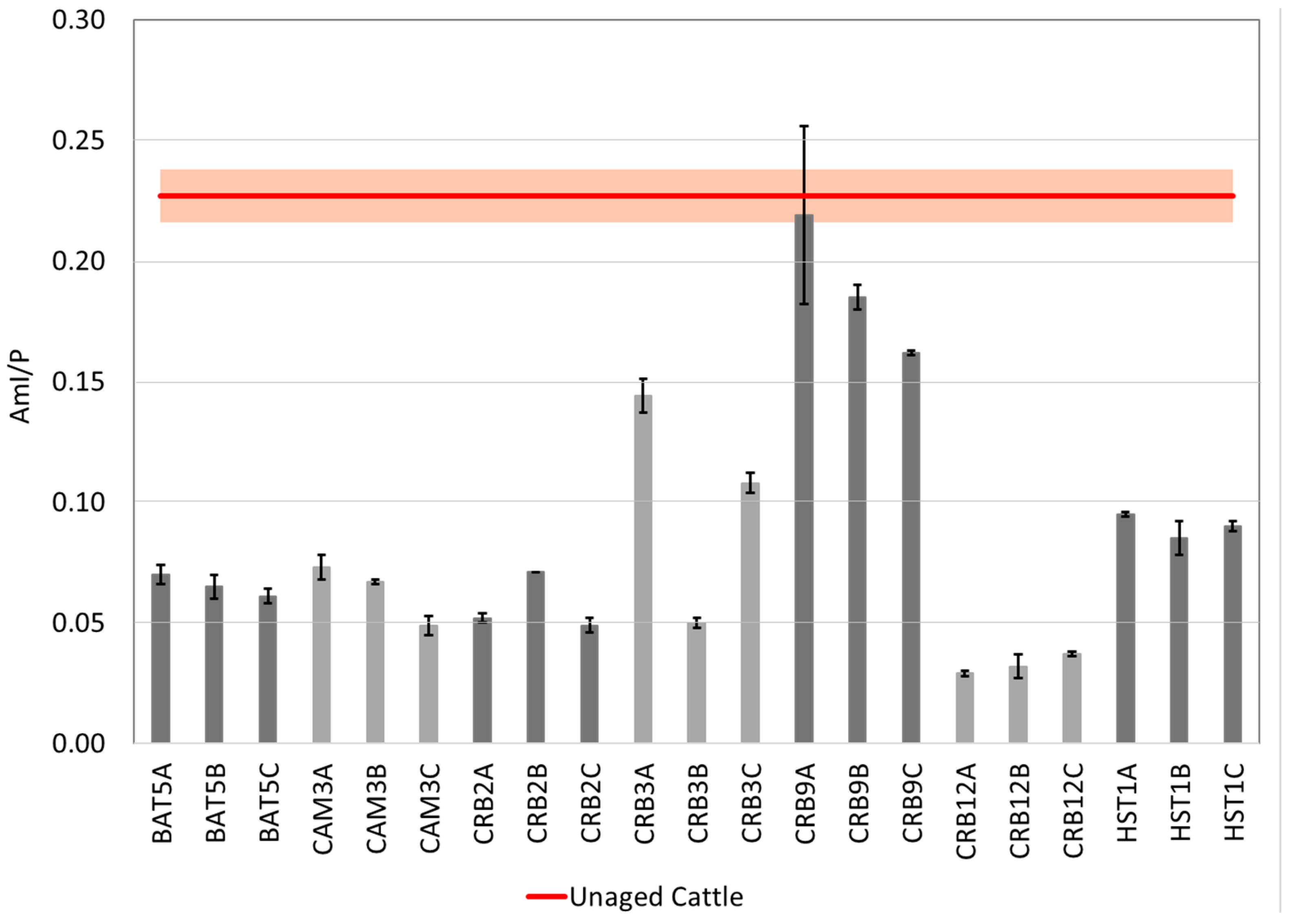
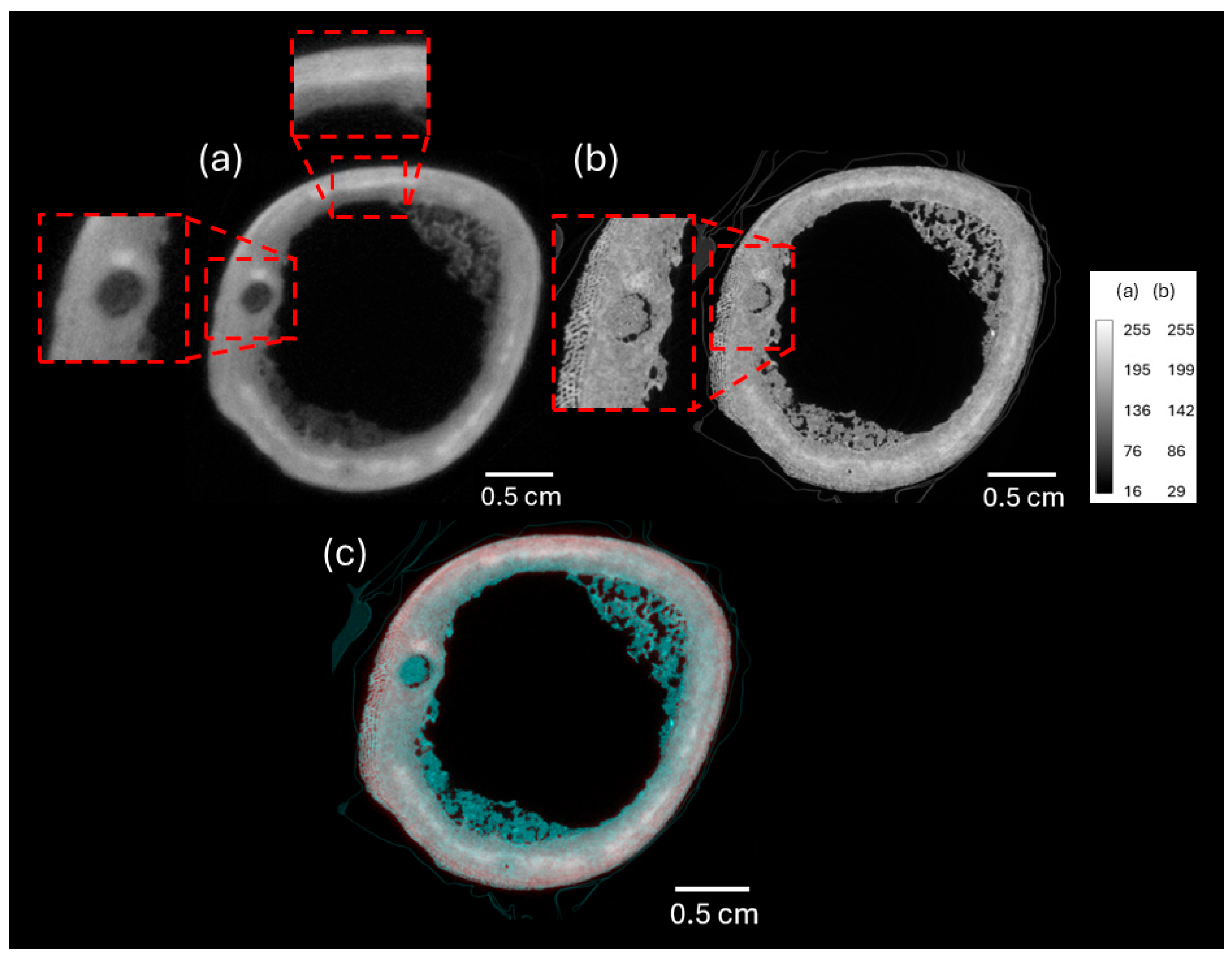
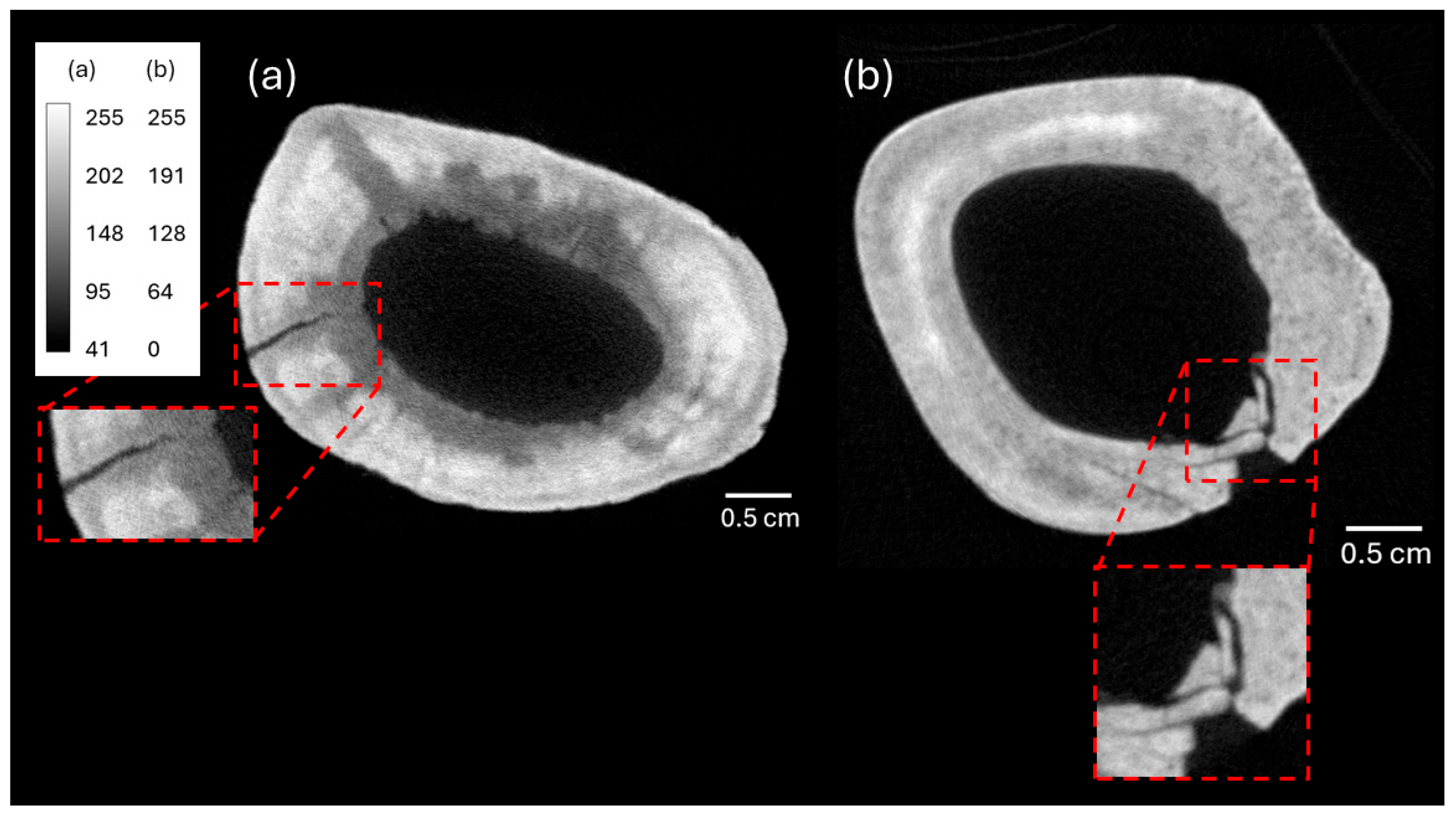
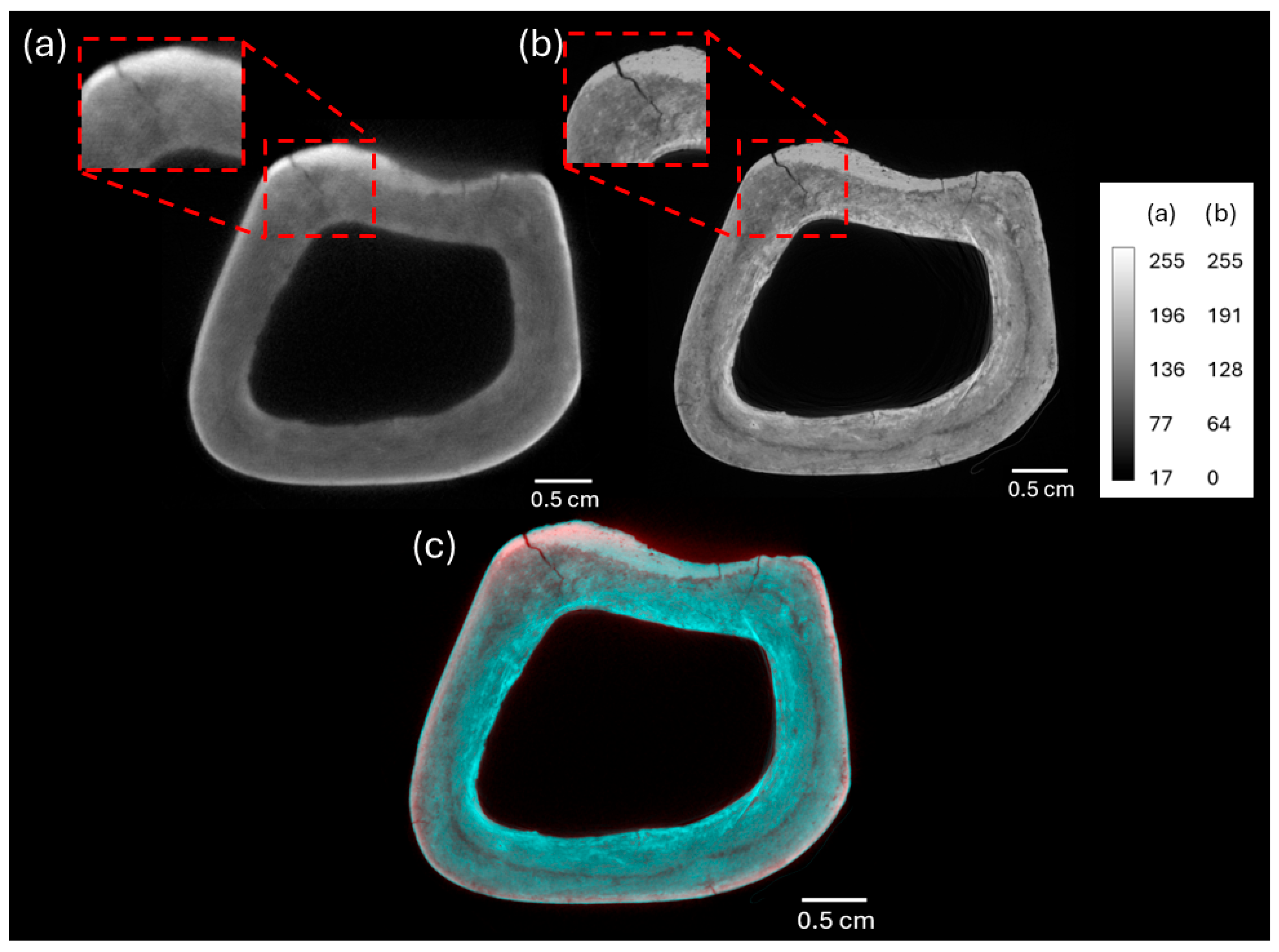
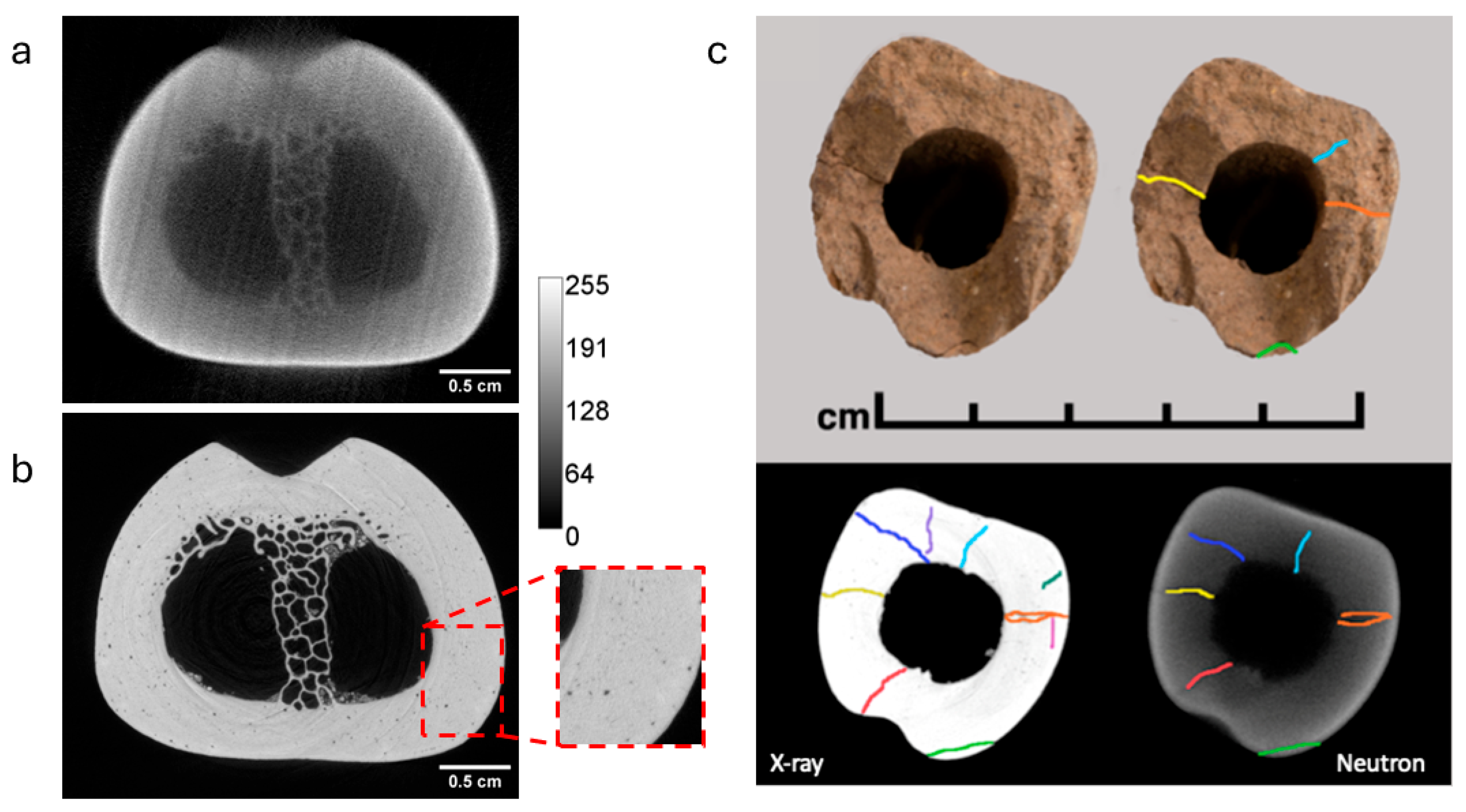
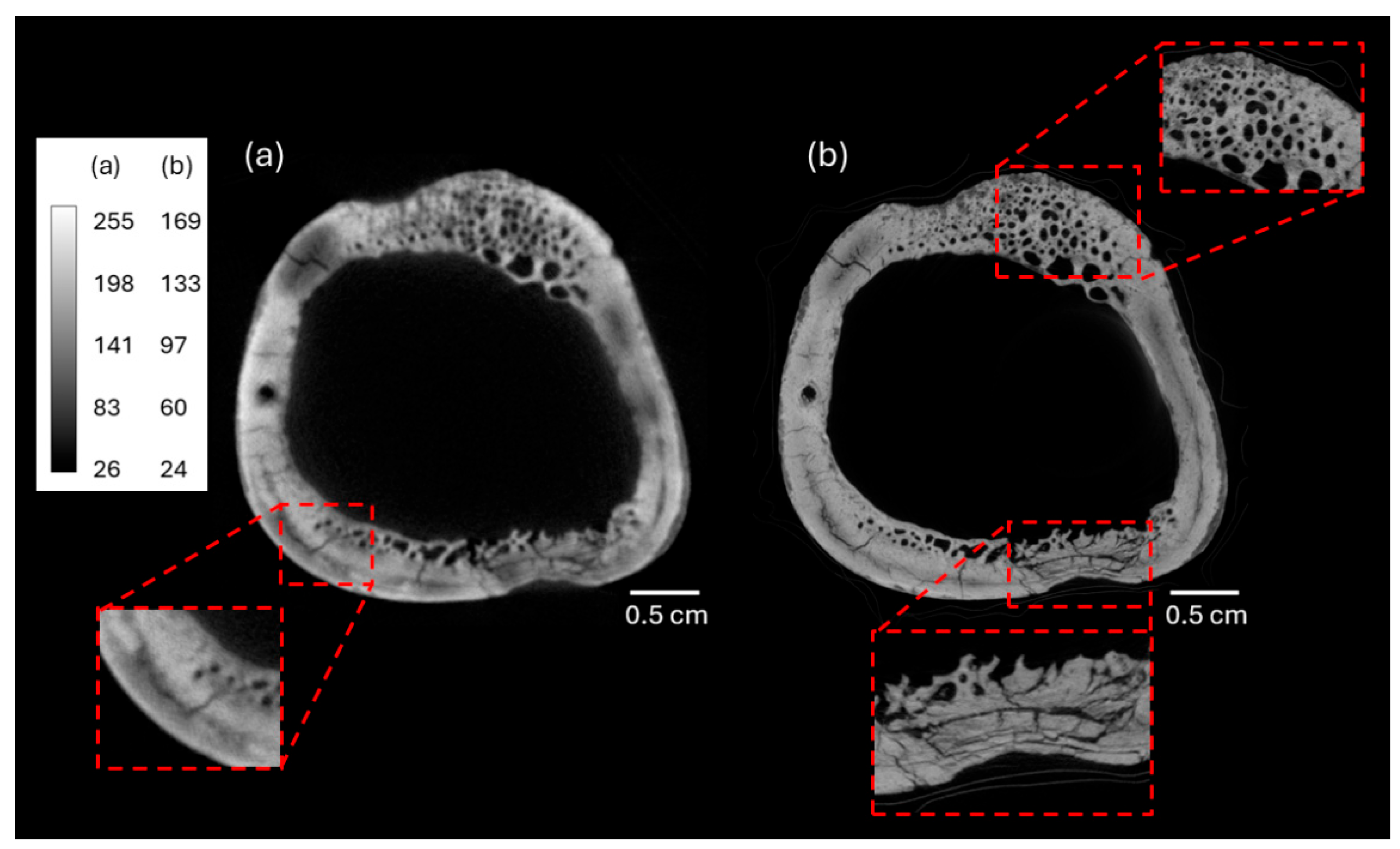
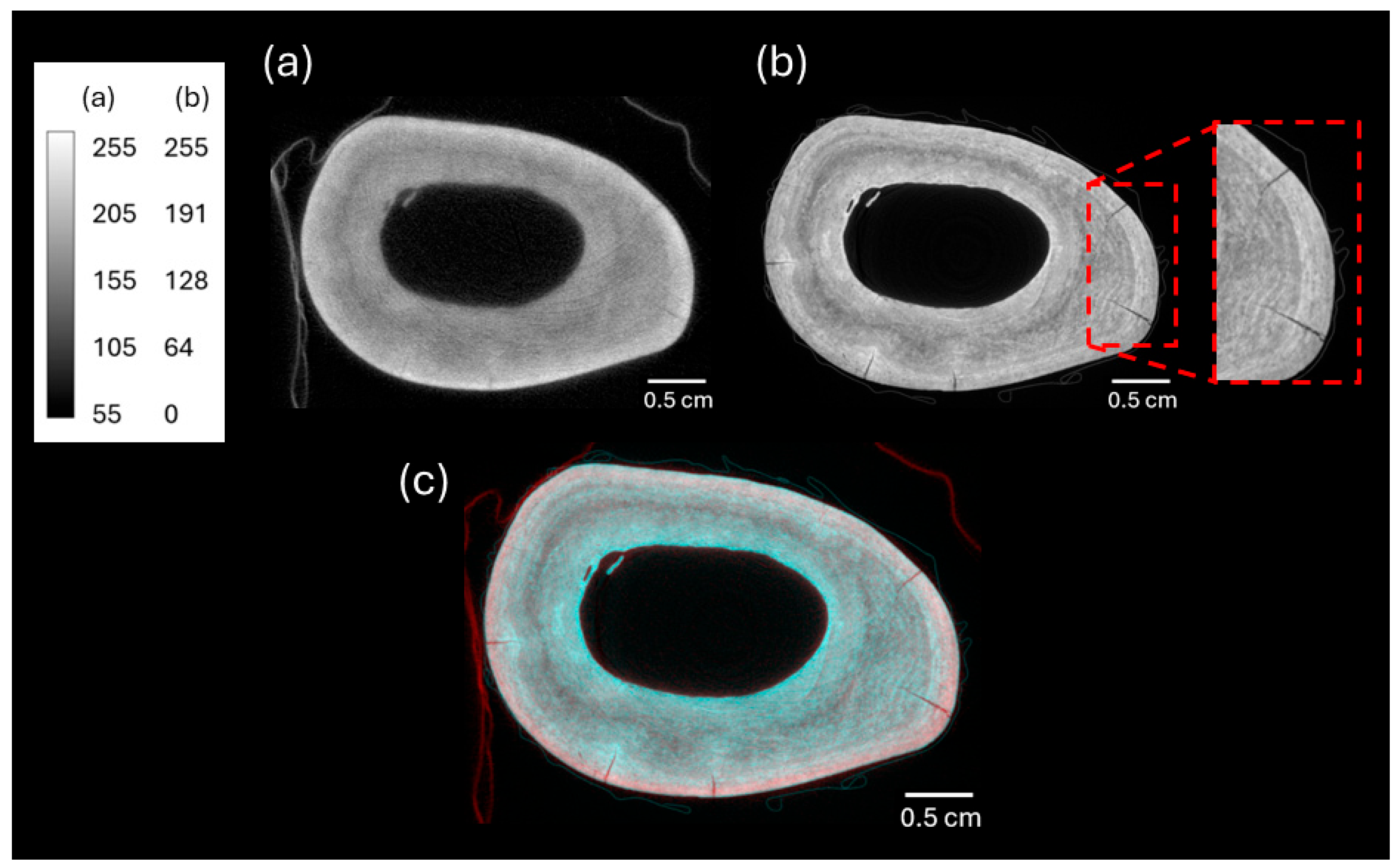
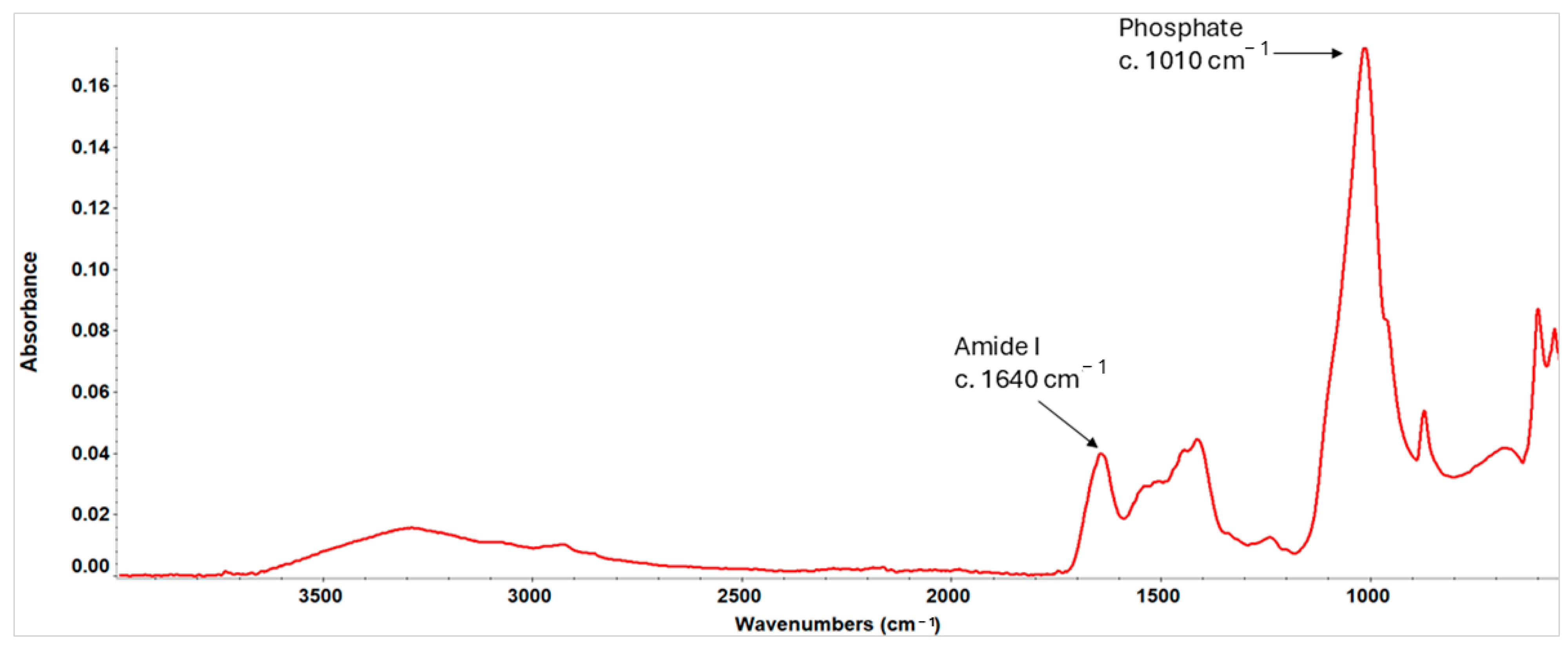
| Scheme | Site | Period | Excavation | Species | Age |
|---|---|---|---|---|---|
| BAT5 | Battle Abbey | Medieval | 1978–80 | Cattle | Juvenile |
| CAM3 | Camber Castle | Tudor | 1982–83 | Cattle | Adult |
| CRB2 | Corbridge | Roman | 1966–67 | Cattle | Adult |
| CRB3 | Corbridge | Roman | 1966–67 | Large mammal | Adult |
| CRB9 | Corbridge | Roman | 1966–67 | Cattle | Adult |
| CRB12 | Corbridge | Roman | 1966–67 | Cattle | Adult |
| HST1 | Housesteads | Roman | 1984 | Cattle | Sub-adult |
| Sample | Location | P Kα | Ca Kα | Mn Kα | Fe Kα | Cu Kα | Zn Kα | Pb Lα |
|---|---|---|---|---|---|---|---|---|
| BAT5 | X1 | m | M | T | m | t | m | m |
| BAT5 | X2 | t | M | t | m | t | t | |
| CAM3 | X1 | m | M | m | t | t | m | |
| CAM3 | X2 | m | M | t | m | t | t | m |
| CRB2 | X1 | t | M | t | M | t | ||
| CRB2 | X2 | m | M | m | M | t | t | |
| CRB3 | X1 | m | M | t | m | t | m | m |
| CRB3 | X2 | m | M | m | M | t | m | m |
| CRB9 | X1 | m | M | m | M | t | m | t |
| CRB9 | X2 | m | M | m | M | t | m | t |
| CRB12 | X1 | m | M | m | m | t | m | |
| CRB12 | X2 | m | M | m | M | t | m | |
| HST1 | X1 | m | M | t | m | t | t | |
| HST1 | X2 | t | M | t | m | t | t | |
| HST1 | X3 | t | M | t | M | t | t |
Disclaimer/Publisher’s Note: The statements, opinions and data contained in all publications are solely those of the individual author(s) and contributor(s) and not of MDPI and/or the editor(s). MDPI and/or the editor(s) disclaim responsibility for any injury to people or property resulting from any ideas, methods, instructions or products referred to in the content. |
© 2025 by the authors. Licensee MDPI, Basel, Switzerland. This article is an open access article distributed under the terms and conditions of the Creative Commons Attribution (CC BY) license (https://creativecommons.org/licenses/by/4.0/).
Share and Cite
Pearce, C.; Léonard, F.; Magdysyuk, O.V.; Thickett, D.; Burca, G.; Odlyha, M. Non-Invasive Preservation Assessment of Archaeological Animal Bones by Complementary Imaging Techniques. Heritage 2025, 8, 347. https://doi.org/10.3390/heritage8090347
Pearce C, Léonard F, Magdysyuk OV, Thickett D, Burca G, Odlyha M. Non-Invasive Preservation Assessment of Archaeological Animal Bones by Complementary Imaging Techniques. Heritage. 2025; 8(9):347. https://doi.org/10.3390/heritage8090347
Chicago/Turabian StylePearce, Chloe, Fabien Léonard, Oxana V. Magdysyuk, David Thickett, Genoveva Burca, and Marianne Odlyha. 2025. "Non-Invasive Preservation Assessment of Archaeological Animal Bones by Complementary Imaging Techniques" Heritage 8, no. 9: 347. https://doi.org/10.3390/heritage8090347
APA StylePearce, C., Léonard, F., Magdysyuk, O. V., Thickett, D., Burca, G., & Odlyha, M. (2025). Non-Invasive Preservation Assessment of Archaeological Animal Bones by Complementary Imaging Techniques. Heritage, 8(9), 347. https://doi.org/10.3390/heritage8090347






